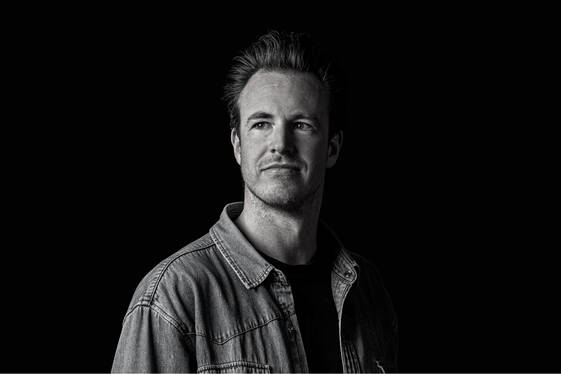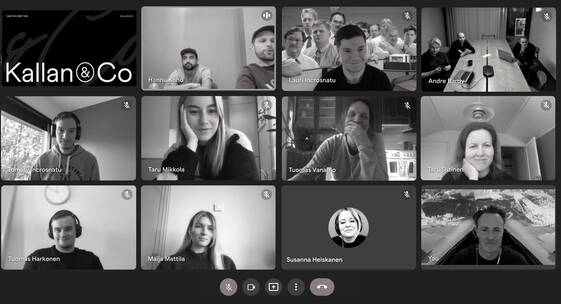Southern Stories is a series of interviews with designers from or working in the South Island about what it is like to be a creative or run a design-led business there. This week we talk to Brett King from Kallan & Co.
DINZ Interview
Southern Stories - I should try to sleep more

Q: You live in Christchurch but work for a Finnish firm… how did that come about, do you ever get any sleep, and if so, in what time zone?!
Brett: There is a lot to unpack there, but you summed it up, basically! My relationship with Finland goes back and forth over the span of my practicing career and culminating in establishing a company there nine years ago with some other designers and strategists. I have been working remotely in Ōtautahi for a majority of that time.
Kallan & Co is a design company, an ongoing experiment and collaboration to help our global customers prosper in a digital future and with a longstanding, remote working culture we thrive on trust. But we do relish the value of studio time when we can get it and I survive on a very unhealthy amount of sleep a day.

So, pre-Covid were you travelling back and forth between NZ and FIN on a regular basis?
Brett: Yes, we were returning somewhat regularly to Helsinki, but it does take a toll traveling with young children. I actually feel slightly relieved we don’t have to do it for a while. Although like most of us who are lucky enough to venture further abroad I do miss the feeling of being shaken out of my everyday routine and immersed in another environment which can be ‘inspiring’.
Being a ‘global’ designer while based in Christchurch must have its share of difficulties and perks… right?
Brett: Working mostly remote for this long you would think I would have a routine dialed but every week is different. Part of our studio process is a 24/6 working cycle which is useful for our United States clients who like a lot of output in a more demanding timeframe. This working model does take the heat off slaving away all night long and is also one of the major perks, waking up in the morning to see fresh ideas and what the team have created overnight and vice versa, I can hand over the projects at the end of my day in this game of creative ping pong.
The downsides; It can be exhausting at times. Daylight-saving really messes up the schedules, evening meetings creep into dinner time and when projects are steaming along it can feel like night and day blend together. Most importantly working remotely can wreak havoc on your mental state if you don’t have someone to bounce ideas off of.
But... the Finns have a national culture of long vacations, over the European summer they all take off for six weeks unplugged and, like us, are big proponents of enjoying the outdoors and a good work-life balance so I try to break up the chaos with a surf or walking the dog and enjoy the seasons here.
What advice would you give to someone wanting to work remotely, from the South Island, and across hemispheres?Brett: It seems clear from this therapy session [AKA interview!] I should try to sleep more. I don’t have any great advice except the practicalities. Find a good timezone meeting app, enjoy your daylight hours, breathe deep, go for a walk, eat lunch away from your computer and connect with others in the design industry for your own sanity. The work permeates your life so use your time to your advantage and be strong to switch off when you can.
Note to self.
Do you think your geographical location influences your creative output?
Brett: Working in isolation leads to unexpected creative results, and I’d like to think that’s a reflection of place.
I can only speak for myself and my experiences, and with any culture clash there are some humorous nuances in this case it works quite nicely, I’m a maximiser and they are minimalists. We compliment each other well, we have great discussions when to dial ideas back and when to run with more, it’s all very fluid when we hit our creative rhythm and work intuitively with each other.
Perhaps our cultures could somewhat be reflected by our natural surroundings, the nordics with their pragmatic, harmonious forests vs Aotearoa with our rugged coastline and dense, native bush but at the end of the day the key to creative output in any scenario is being held accountable to the work so it does depend on what projects are in the pipeline and how the ideas are flowing.
Is there something about being a creative in the South Island that you feel is entirely unique?
Brett: We all breathe the same air, absorb the same feeds and appreciate the visual joy of good design, there’s just less of us here than in the North Island. I feel like an observer most of the time so my only perspective is that of being on the fringe of a small country that packs well above its weight in design. The design community here is small and sporadic, but the DINZ events are a great place to catch up with everyone and Smash Palace is probably pouring the glue that holds it all together!
What is the one cultural, design, culinary, artistic or other object or person from Christchurch you think has been under-represented and should, by now, be considered an icon?
Brett: This is a tough question. There was a lot of stunning architecture, wiped out from a seismic event and there still are many gems tucked away in corners of the city.
I was lucky enough to rent a space in the NG building for six years, a building that was proposed to be demolished to make way for a stadium in the heart of the city. It is the last remaining building of that early 1900s ‘warehouse’ category, and before the earthquakes the buildings were all over the city, often cheaper to rent and fostering an underground creative pulse, but it's hard to ignore the visual metaphor for Te Waipounamu. A stadium vs a small warehouse full of creative types. Our landlords won the case eventually and the building will be moved to a new site by this time next year.